Learn the NFPA systems and essential fire safety guidelines for hospitals and other medical facilities
A 2013 study published in the Journal of Clinical Anesthesia concluded that “Fire happens with alarming frequency and [with] potentially devastating consequences in hospitals around the world.” NFPA Journal summarized the study and global news reports that show how poor hospital fire safety leads to hundreds of deaths in Algeria, South Korea, Brazil, China, India, and Russia. Hospitals in the United States, however, are much safer.
US fire departments respond to about 1,100 hospital fires annually, and the most current National Fire Protection Association (NFPA) data show that less than one death per year occurs in these fires. The reason for this exceptional safety record? The United States’ strict adherence to and enforcement of building and fire codes and standards.
The two primary codes that outline requirements for healthcare occupancies and hospital fire safety are NFPA 99: Health Care Facilities Code and NFPA 101: Life Safety Code.* This article explains how these documents define healthcare occupancies while providing an overview of the requirements that keep these facilities safe.
*All code references in this blog are from the most current editions of NFPA. However, The Centers for Medicare & Medicaid Services (CMS) guidelines for healthcare facilities are still based on the 2012 edition of NFPA 101.
Defining health care environments
NFPA 101: Life Safety Code defines several types of healthcare-related facilities: hospitals, ambulatory care centers, and doctor’s offices. These all have their own requirements and are defined as follows:
From the 2018 edition of NFPA 101
3.3.150 Hospital. A building or portion thereof used on a 24-hour basis for the medical, psychiatric, obstetrical, or surgical care of four or more inpatients.
3.3.196.1 Ambulatory Health Care Occupancy. An occupancy used to provide services or treatment simultaneously to four or more patients that provides, on an outpatient basis, one or more of the following: (1) treatment for patients that renders the patients incapable of taking action for self-preservation under emergency conditions without the assistance of others; (2) anesthesia that rends the patients incapable of taking action for self-preservation under emergency conditions without the assistance of others; (3) treatment for patients who, due to the nature of their injury or illness, are incapable of taking action for self-preservation under emergency conditions without the assistance of others.
3.3.196.3* Business Occupancy. An occupancy used for the transaction of business other than mercantile. [A.3.3.196.3 … Doctors’ and dentists’ offices are included, unless of such character to be classified as ambulatory health care occupancies.]
3.3.196.7 Health Care Occupancy. An occupancy used to provide medical or other treatment or care simultaneously to four or more patients on an inpatient basis, where such patients are mostly incapable of self-preservation due to age, physical or mental disability, or because of security measures not under the occupants’ control.
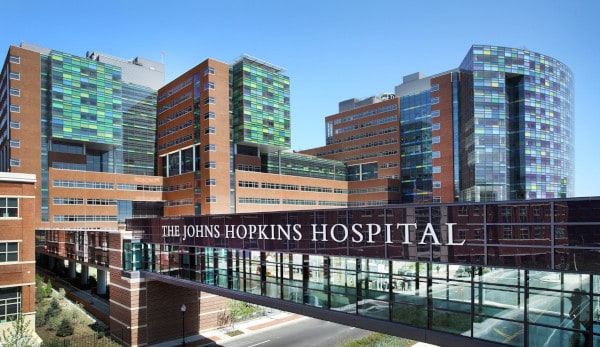
Understanding functional systems in hospitals
Hospitals function like a dynamic, living organism, made up of multiple systems working together. It is critical to the success of facility operations that various systems remain in working condition, including gas, ventilation/HVAC, electrical, communications, plumbing, fire protection, and operations. Each system is classified by the risk its failure poses to losing lives or causing injuries or discomfort. NFPA 99 outlines four risk categories:
From the 2018 edition of NFPA 99
4.1* Risk Categories. Activities, systems, or equipment shall be designed to meet Category 1 through Category 4 requirements, as detailed in this code.
4.1.1* Category 1. Activities, systems, or equipment whose failure is likely to cause major injury or death of patients, staff, or visitors shall be designed to meet Category 1 requirements as detailed in this code.
4.1.2* Category 2. Activities, systems, or equipment whose failure is likely to cause minor injury of patents, staff, or visitors shall be designed to meet Category 2 requirements, as detailed in this code.
4.1.3 Category 3. Activities, systems, or equipment whose failure is not likely to cause injury to patients, staff, or visitors, but can cause discomfort, shall be designed to meet Category 3 requirements, as detailed in this code.
4.1.4 Category 4. Activities, systems, or equipment whose failure would have no impact on patient care shall be designed to meet Category 4 requirements, as detailed in this code.
Each category of system must meet the applicable requirements of NFPA 99, and specific systems may have a separate standard for installation and maintenance.
Gas and Vacuum Systems. The installation of these systems is outlined in Chapter 5 of NFPA 99. Additionally, cryogenic fluids for oxygen supply must comply with NFPA 55: Compressed Gases and Cryogenic Fluids Code.
Electrical Systems. All electrical installations must comply with NFPA 70: National Electrical Code (NEC)® and the specific requirements of Chapter 6 of NFPA 99. When generator sets are utilized where an alternate power source is required, they must be installed and maintained following NFPA 110: Standard for Emergency and Standby Power Systems.
Information Technology and Communications Systems. Fiber and copper installations must comply with NFPA 70: National Electrical Code (NEC). All other requirements for these systems are outlined in Chapter 7 of NFPA 99.
Plumbing. These systems must comply with the requirements listed in Chapter 8 of NFPA 99.
Heating, Ventilation, and Air Conditioning (HVAC). These systems are addressed in Chapter 9 of NFPA 99. Ductwork and air supply must be installed in accordance with NFPA 90A: Standard for the Installation of Air-Conditioning and Ventilating Systems. All gas systems other than medical equipment must be provided with ventilation that meets requirements in NFPA 55: Compressed Gases and Cryogenic Fluids Code.
Other areas. Other spaces within a hospital setting should be protected per the following standards and requirements:
- Hyperbaric facilities should be constructed and protected following Chapter 14 of NFPA 99.
- Laboratories and clean rooms shall comply with NFPA 45: Standard on Fire Protection for Laboratories Using Chemicals.
- Waste and linen chutes must meet the requirements of NFPA 82: Standard on Incinerators and Waste and Linen Handling Systems and Equipment.
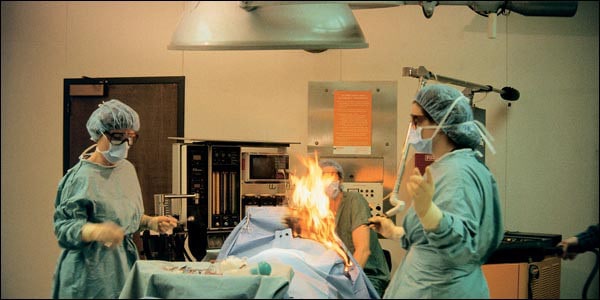
Fire safety guidelines for hospitals
Individual fire protection and life safety measures are part of a system. No single fire protection feature can be effective without other supporting elements. For example, a fire sprinkler system without an alarm or compartmentation may not be able to do its job adequately. Without an alarm, there would be no notification that a fire is occurring and that action should be taken. Without compartmentation, the fire could grow unimpeded, and it might quickly overcome the capabilities of a fire sprinkler system.
In the following paragraphs (and our downloadable hospital fire safety checklist), we examine the NFPA codes and standards references that ensure fire protection and life safety systems work as intended. These items include compartmentation, fire sprinklers, specialized fire suppression systems and extinguishers, fire alarms, backup power, and safety operations and plans.
Compartmentation in medical facilities
Chapter 18 of NFPA 101 outlines the construction and design requirements for a medical structure. Many of these specs focus on compartmentation, which is a passive fire protection system that prevents or slows the spread of fire by walling it off. Included in the rules is the required fire rating of walls, doors, and corridors for patient rooms, operating areas, special hazard spaces, and egress paths.
These surfaces must remain intact to ensure that their required fire-resistance rating is in place. Any openings in a fire-resistance-rated wall must be adequately sealed or protected. This requires appropriately rated fire doors, windows, and transfer grilles.
From the 2018 edition of NFPA 101
8.3.3.1 General. Every opening in a fire barrier shall be protected to limit the spread of fire from one side of the fire barrier to the other.
As hospital facilities are maintained and updated, various trade workers and equipment have to penetrate the fire-rated walls; these holes may be for IT/communications cables, ductwork, or a myriad of other items. Each opening that penetrates the fire-rated barrier must be properly sealed and fire-stopped. And areas that are prone to penetrations should be documented and frequently inspected.
From the 2018 edition of NFPA 101
8.3.4.2* Firestop Systems and Devices Required.
8.3.4.2.1 Penetrations for cables, cable trays, conduits, pipes, tubes, combustion vents and exhaust vents, wires, and similar items to accommodate electrical, mechanical, plumbing, and communications systems that pass through a wall, floor, or floor/ceiling assembly constructed as a fire barrier shall be protected by a firestop system or device.
Fire sprinklers in hospitals
Fire sprinklers must be installed throughout healthcare occupancies. These systems are installed following NFPA 13: Standard for the Installation of Sprinkler Systems, and they are maintained according to NFPA 25: Standard for the Inspection, Testing, and Maintenance of Water-Based Fire Protection Systems.
NFPA 25 outlines the required inspection, testing, and maintenance (ITM) frequency and procedures. Major system components are required to be inspected quarterly, semi-annually, and annually. At each of these intervals, specific items must be maintained and tested. There are also weekly and monthly inspection requirements for items that must only be visually inspected—these components include gauges, valves, private hydrants, and fire pumps.
Read our series about commercial fire sprinkler inspection requirements to learn more.
The primary concern for facility managers is ensuring that these inspections, maintenance, and testing are completed by a qualified fire sprinkler professional and documented. Careful recordkeeping of sprinkler system ITM is a critical component to ensuring system reliability, and it is required for any form of agency accreditation.
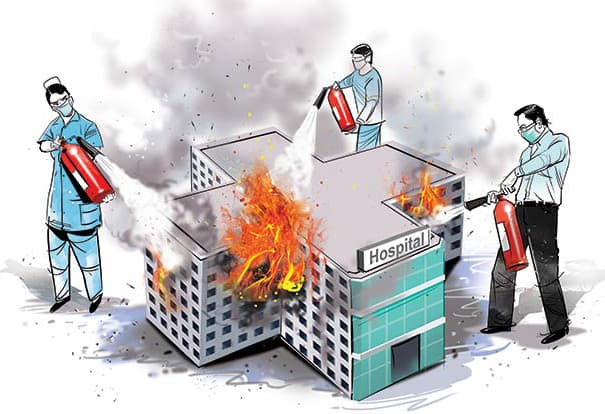
Fire extinguishers and specialized fire suppression systems
Fire extinguishers are required throughout the building. These must be selected, placed, inspected, tested, and maintained following the rules in NFPA 10: Standard for Portable Fire Extinguishers.
Any commercial kitchen and cooking facilities in a medical facility must be protected with a hood and fire suppression system, which requires semi-annual inspections, testing, and maintenance. Additionally, the filters and exhaust ductwork that make up the hood system require regular cleaning—the frequency of which is based on the amount of grease that is used in the cooking process. These specific requirements are outlined in NFPA 96: Standard for Ventilation Control and Fire Protection of Commercial Cooking Operations.
Hospitals are provided with an exception to protecting cooking appliances when “residential” cooking equipment is employed for light use, food warming, and reheating. This allows for using appliances such as microwaves, hot plates, or toasters without requiring them to be under a hood or protected with a dedicated fire suppression system.
Fire alarms in medical facilities
NFPA requires a fire alarm system throughout the facility. NFPA 72: National Fire Alarm and Signaling Code, outlines the installation and ITM requirements for these systems. A facility manager should understand the basic operation of fire alarms and what the various signals may mean. Quarterly, semi-annual, and annual system inspection, testing, and maintenance are required, and diligent records must be maintained of all ITM work and results.
Generator sets and alternate power sources
NFPA 99 introduces the term EES: essential electrical systems.
From the 2018 edition of NFPA 99
3.3.51* Essential Electrical System. A system comprised of alternate sources of power and all connected distribution systems and ancillary equipment, designed to ensure continuity of electrical power to designated areas and functions of a healthcare facility during disruption of normal power sources, and also to minimize disruption within the internal wiring system.
Based on the risk category of the healthcare space (see above), an alternate power source, such as a generator, may be required to maintain the EES:
- Category 1 spaces required a Type I EES.
- Category 2 spaces can utilize either a Type I or a Type II EES.
- Category 3 and 4 spaces do not require an EES.
Where required, the EES must meet the requirements of NFPA 110: Standard for Emergency and Standby Power Systems, for a Type 10, Class X, Level 1 generator set.
The alternate power source used to maintain an EES must be maintained following the requirements of Chapter 8 of NFPA 110. This testing requires the generator set to be run least 12 times per year, and the critical operating components must be visually inspected. Records of these run times and visual inspections must be maintained and made available to the inspecting authority having jurisdiction (AHJ).
From the 2018 edition of NFPA 99
6.7.4. Record Keeping. A written record of inspection, performance, exercising period, and repairs shall be regularly maintained and available for inspection by the authority having jurisdiction.
Operations and plans
Healthcare facilities must maintain emergency and evacuation plans, and employees must be regularly trained on these plans and their roles within them. Emergency plans should include instructions for fire emergencies and general building evacuations.
Quarterly evacuation drills are required for each shift, and records of these drills must be maintained. Additionally, hospital staff should be aware of and sustain general housekeeping standards. These activities include maintaining clear access to exits, enforcing “no smoking” policies, making sure decorations in halls and patient rooms are fire resistant and do not exceed allowed limits, and ensuring soiled linens and trash are regularly emptied and not permitted to accumulate beyond allowed maximums (0.5 gallons per room, 32 gallons total in a protected area).
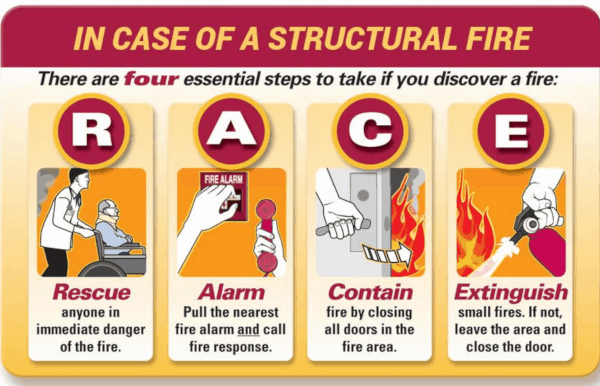
Hospital fire safety: Complicated rules, but a fantastic track record of safety in the US
The last of the major hospital fires in the United States occurred in the 1980s. And in that era, nearly 8,000 fires occurred in hospitals annually. Today’s relatively low frequency of hospital fires—a drop of about 86% in a few decades—and the extremely low fatality rate are due to measures and systems like compartmentation, active fire suppression, fire alarms, and safe and reliable alternative power supplies. Additionally, the inspections and accreditation process for hospitals places an extremely high priority on hospital fire safety.
Nevertheless, it’s a complicated and time-consuming job to track and maintain all of the required systems that are necessary to ensure a fire-safe medical facility. Our downloadable hospital fire safety checklist makes things a little easier.
It points you to the exact sections of NFPA 101 and NFPA 99 that govern various installation, inspection, testing, and maintenance requirements and helps you ensure that all items, tasks, and documentation are in place. This resource tells you where to look in these huge NFPA documents, helping hospital facility managers and other stakeholders prepare for audits and fire inspections.
Do you need equipment to keep your hospital up to code? Browse our selection of commercial fire sprinklers, concealed sprinkler cover plates (including cover plates designed for cleanrooms), standpipe and FDC components, fire extinguishers, and Shutguns that quickly shut down accidentally activated sprinkler heads.
Questions about QRFS products or need an item that’s not in our online inventory? Just call us at +1 (888) 361-6662 or email support@qrfs.com.
This blog was originally posted at blog.qrfs.com. Check us out at Facebook.com/QuickResponseFireSupply or on Twitter @QuickResponseFS.


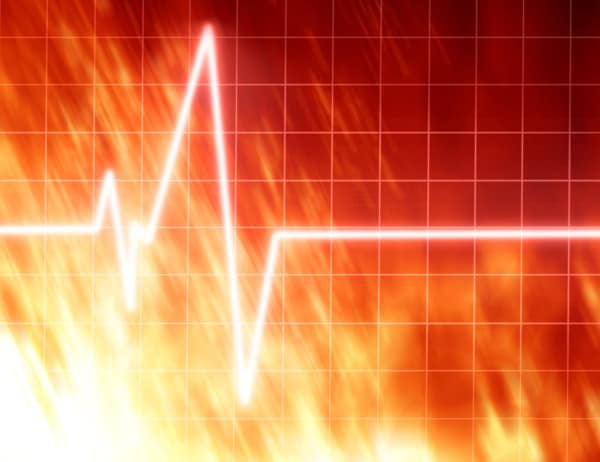
HOSPITAL FIRE AND SAFETY AUDIT CHECKLIST
Can we provide the water based sprinkler system in ICU’s
Suresh – Yes, wet sprinkler systems can be installed in ICUs, and various US government codes and international model codes *require sprinklers* in these settings. That said, in areas where expensive medical equipment may be subject to water damage, including ICUs and surgical rooms, a preaction system that lessens the odds of accidental activation may be used. Also, cleanrooms and other sterile environments benefit from using concealed fire sprinklers with cleanroom covers as part of a wet system. Hope that helps!
Generally what type of sprinkler systems is installed in hospital of example categories Cat-1, 2 and 3 ,respectively?.
For 3 or 4 story hospital building : What are the water header pressure required.
Appreciate your kind reply.Thank you
Manny
Manny — For your first specific system application question, you can try our Ask a Fire Pro service—but the exact pressure required cannot be determined without a full system assessment done by a design professional. You can click the link to submit your first question with some information about your building, and a fire protection professional will provide an answer based on best practices, standards, and codes. Our pros include AHJs, contractors, engineers, and code experts with 150+ years of combined experience!
What version of NFPA 72 is the Joint Commission currently using? To inspect fire alarm systems in a VA hospital?
Katie — We aren’t sure if the Joint Commission is referencing the latest 2022 standard, though it references a pretty old edition (2010) in the “inspections — fire safety format” FAQs. You may want to contact them here with your question. Thanks!
for hospital toilet with shower shall we install sprinkler?
bong — The rules governing where sprinklers must be installed in a building are in NFPA 13: Standard for the Installation of Sprinkler Systems. In contrast, other codes (locally enforceable codes and model codes they are based on) govern the settings/facilities where sprinkler systems must be installed (like hospitals) while following NFPA 13 rules.
In NFPA 13 (2022 edition), you can refer to “Section 9.2.4.1 Bathrooms.” The only exceptions for sprinklering bathrooms are:
1. “9.2.4.1.1* Unless sprinklers are required by 9.2.4.1.2 or 9.2.4.1.3, sprinklers shall not be required in bathrooms that are located within dwelling units, that do not exceed 55 ft2 (5.1 m2) in area, and that have walls and ceilings of noncombustible or limited-combustible materials with a 15-minute thermal barrier rating, including the walls and ceilings behind any shower enclosure or tub.”
2. “9.2.4.1.1.1 Bathrooms in accordance with 9.2.4.1.1 that are located under stairs that are part of the path of egress shall not be required to be protected provided that the bathroom is separated from the stairs by fire-resistive construction in accordance with the local building code.”
And while the standard doesn’t single out hospitals, section 9.1.4.1.2 explicitly requires sprinklers “in bathrooms of limited care facilities and nursing homes, as defined in NFPA 101.”
Thus, yes, it is likely the hospital bathroom you are asking about requires sprinklers, subject to your local codes, the specific requirements, and the specific bathroom you are referencing, etc. You should contact the local authority having jurisdiction and/or a qualified fire protection professional to assess the situation and provide actionable guidance.
Thank you for respond. Our project KUWAIT CHILDREN HOSPITAL(KCH) I’m doing QAQC. I need some references only.
I”m working at consultant here in kuwait since 2002 .
Thanks for additional insight.
God bless you more
Does it say anywhere in the code or any other standard that we need to have fire safety staff coverage in hospital 24 hours 7 days a week?
Osama — Codes vary and are location dependent, and hospitals have their own unique rules/standards bodies. We’re also not 100% sure what you intend by “fire safety staff coverage.” For example, that could mean a fire watch if systems are down. However, depending on the healthcare occupancy and the fire alarm system present, etc., 24/7 coverage of a “constantly attended location” to receive alarm activation signals may be required. You can submit a question to our Ask a Fire Pro service for a well-researched answer from a qualified and experienced fire pro that’s specific to your situation. Otherwise, NFPA 72 is a great place to start for alarms, and the applicable enforceable code detailing what systems are necessary is also relevant. Thanks!
how frequent we need to clean the fire hydrant water storage tank
Ajish — Unfortunately, we are not aware of requirements for “fire hydrant storage;” did you mean storage tanks serving a fire sprinkler system?
Question on the Hospital Fire Safety Checklist, it references NFPA 1010, 8.8 to do monthly inspection of fire and egress doors conducted and documented. When I look on-line I don’t seem to be able to find this requirement. Can you help me with finding this requirement and where TJC says they require this under EC.02.03.05. Thank you
Caryn — We doublechecked this, and it seems to be an error (and typo). Inspections of door assemblies in NFPA 101 and NFPA 80 indicate “annually” or a “at least annually” for difference types. We will get this updated after validating, and thanks for bring the error to our attention!
Ours is a small Pediatric Clinic Hospital, wherein wireless smoke detector systems are placed. Is it mandatory to have wired smoke detectors instead of wireless system?
Please response.
Vijay — Unfortunately, we cannot assess specific code requirements in this forum, especially without knowledge of your specific jurisdiction and more details about the property and its systems. If you’d like a more authoritative but informal interpretation, you can try our Ask a Fire Pro service, where we’ll gather more information and run the scenario by a qualified AHJ and code expert. Thanks for reading!